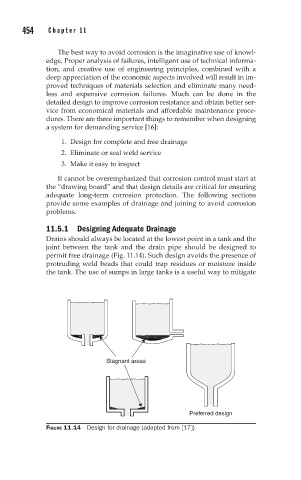Page 487 - Corrosion Engineering Principles and Practice
P. 487
454 C h a p t e r 1 1 M a t e r i a l s S e l e c t i o n , Te s t i n g , a n d D e s i g n C o n s i d e r a t i o n s 455
The best way to avoid corrosion is the imaginative use of knowl-
edge. Proper analysis of failures, intelligent use of technical informa-
tion, and creative use of engineering principles, combined with a
deep appreciation of the economic aspects involved will result in im-
proved techniques of materials selection and eliminate many need-
less and expensive corrosion failures. Much can be done in the
detailed design to improve corrosion resistance and obtain better ser-
vice from economical materials and affordable maintenance proce-
dures. There are three important things to remember when designing
a system for demanding service [16]:
1. Design for complete and free drainage
2. Eliminate or seal weld service
3. Make it easy to inspect
It cannot be overemphasized that corrosion control must start at
the “drawing board” and that design details are critical for ensuring
adequate long-term corrosion protection. The following sections
provide some examples of drainage and joining to avoid corrosion
problems.
11.5.1 Designing Adequate Drainage
Drains should always be located at the lowest point in a tank and the
joint between the tank and the drain pipe should be designed to
permit free drainage (Fig. 11.14). Such design avoids the presence of
protruding weld beads that could trap residues or moisture inside
the tank. The use of sumps in large tanks is a useful way to mitigate
Stagnant areas
Preferred design
FIGURE 11.14 Design for drainage (adapted from [17]).

